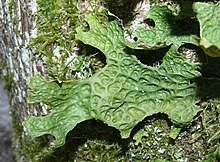Lobaria pulmonaria
| Lobaria pulmonaria[1][2] | |
|---|---|

| |
| Scientific classification | |
| Domain: | Eukaryota |
| Kingdom: | Fungi |
| Division: | Ascomycota |
| Class: | Lecanoromycetes |
| Order: | Peltigerales |
| Family: | Peltigeraceae |
| Genus: | Lobaria |
| Species: | L. pulmonaria
|
| Binomial name | |
| Lobaria pulmonaria | |
Lobaria pulmonaria is a large
Description

It is a
Photobionts
The thallus contains internal structures known as
Reproduction
Lobaria pulmonaria has the ability to form both
Dispersal by vegetative propagules (via soredia or isidia) has been determined as the predominant mode of reproduction in L. pulmonaria.[12][13] In this method, the protruding propagules become dry and brittle during the regular wet/dry cycles of the lichen, and can easily crumble off the thallus. These fragments may develop into new thalli, either at the same locale or at a new site after dispersal by wind or rain.[14] A number of steps are required for the development of the vegetative propagules, including the degeneration of the thallus cortex, replication of green algal cells, and entanglement of fungal hyphae with the green algal cells.[14] These steps lead to an increase in internal pressure which eventually breaks through the cortex. Continued growth leads to these granules being pushed upwards and out of the thallus surface.[15]
Distribution and habitat

It has a wide distribution in
Various environmental factors are thought to affect the distribution of L. pulmonaria, such as temperature, moisture (average humidity, rapidity and frequency of wet-dry cycles), sunlight exposure, and levels of air pollution.[22] Attempts to quantitatively evaluate the contribution of these factors to lichen growth is difficult because differences in the original environment from which the lichen thalli are collected will greatly affect heat and desiccation tolerances.[23]
Due to declining population, L. pulmonaria is considered to be rare or threatened in many parts of the world, especially in lowland areas of Europe.[24][25][26][27][28] The decline has been attributed to industrial forestry[19] and air pollution, particularly acid rain.[29] L. pulmonaria, like other lichens containing a blue-green algal component, are particularly susceptible to the effects of acid rain, because the subsequent decrease in pH reduces nitrogen fixation through inhibition of the algal nitrogenase enzyme.[29]
Chemical compounds
Lobaria pulmonaria is known to contain a variety of acids common to lichens, such as
Also known to be present are various steroids, namely ergosterol, episterol, fecosterol, and lichesterol.[38][39]
Uses
Medicinal
Its shape somewhat resembles the tissue inside
A hot-water
Other uses
Lobaria pulmonaria has also been used to produce an orange dye for wool, in the tanning of leather, in the manufacture of perfumes and as an ingredient in brewing.[46][47]
References
- ^ "Species Fungorum - GSD Species". Retrieved 2009-01-12.
- PMID 17486983.
- ^ "Liber Herbarum II: Lobaria pulmonaria". Retrieved 2009-01-11.
- ^ ISBN 978-0-87071-394-1.
- ^ ISBN 978-0-300-08249-4.
- ISBN 978-0-412-00641-8.
- JSTOR 2430515.
- .
- JSTOR 3241326.
- ^ Scheidegger C, Walser JC. (1998). "Reintroduction and augmentation of populations of the endangered Lobaria pulmonaria: methods and concepts". In: Lobarion Lichens as Indicators of the Primeval Forests of the Eastern Carpathians (eds Kondratyuk S, Coppins B), pp. 33–52. Ukrainian Phytosociological Centre, Kiev.
- PMID 21156641.
- PMID 21653485.
- S2CID 10687660.
- ^ ISBN 978-0-8493-3582-2.
- .
- ^ "Wild places in South Snowdonia". National Trust. Archived from the original on 2022-04-19. Retrieved 2022-07-26.
- from the original on 2022-07-25. Retrieved 2022-07-25.
- ^ K. N. A. ALEXANDER, Historic parks and pasture-woodlands: The National Trust resource and its conservation, Biological Journal of the Linnean Society, Volume 56, Issue suppl_1, December 1995, Pages 155–175.
- ^ doi:10.1139/b04-074.
- JSTOR 3060899.
- JSTOR 3807559.
- ISBN 978-0-471-57885-7.
- JSTOR 3244432.
- S2CID 218890947.
- ^ Colbert, J.T. (2011). "Current Status of Lichen Diversity in Iowa". Journal of the Iowa Academy of Science. 18: 16–23.
- ^ Wirth V, Schöller H, Scholz P, Ernst G, Feuerer T, Gnüchtel A, Hauck M, Jacobsen P, John V, et al. (1996). "Rote Liste der flechten (Lichenes) der Bundesrepublik Deutschland". Schriftenreihe für Vegetationskunde. 28: 307–368.
- ^ Scheidegger C, Clerc P, Dietrich M, Frei M, Groner U, Keller C, Roth I, Stofer S, Vust M. (2002). "Rote Liste der gefährdeten Arten der Schweiz: Baum- und erdbewohnende Flechten". - Bern, Bundesamt für Umwelt, Wald und Landschaft BUWAL; Birmensdorf, Eidgenössische Forschungsanstalt WSL; Conservatoire et Jardin botaniques de la Ville de Genève CJBG. 124 S.
- ^ "Danish Lichen Checklist". Archived from the original on 2011-07-19. Retrieved 2008-12-16.
- ^ .
- ^ a b "www.emea.europa.eu" (PDF). Archived from the original (PDF) on 2007-07-10. Retrieved 2009-01-08.
- .
- S2CID 24451731.
- S2CID 4132695.
- S2CID 11212975.
- PMID 17587375.
- JSTOR 2390282.
- .
- .
- .
- ^ ISBN 978-0-00-220082-0.
- ^ "Lobaria pulmonaria". Archived from the original on 2008-12-23. Retrieved 2009-01-08.
- PMID 18334029.
- PMID 13678242.
- S2CID 206425015.
- S2CID 12814426.
- ^ "Lungwort". Retrieved 2008-12-16.
- S2CID 2123674.
External links
 Media related to Lobaria pulmonaria at Wikimedia Commons
Media related to Lobaria pulmonaria at Wikimedia Commons Data related to Lobaria pulmonaria at Wikispecies
Data related to Lobaria pulmonaria at Wikispecies- University of British Columbia Botany Photo of the Day
- Catherine Daniels: The Biogeography of the Lungwort
